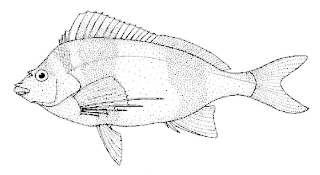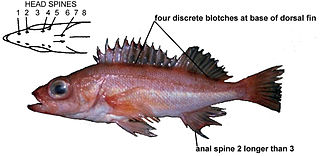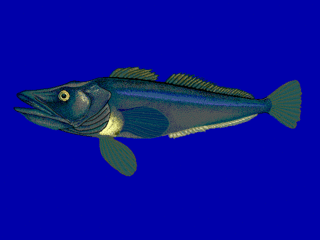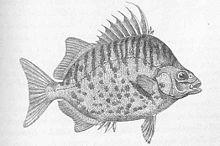
Chironemus is a genus of marine ray finned fish, commonly known as kelpfishes, belonging to the family Chironemidae. They are found in the temperate waters of the Southern Pacific Ocean.

Scatophagidae, the scats are a small family of ray-finned fishes in the order Perciformes. They are found in the Indo-Pacific region but one species has been introduced elsewhere.

The magpie perch, magpie morwong or black-striped morwong, is a species of marine ray-finned fish, traditionally regarded as belonging to the family Cheilodactylidae, the members of which are commonly known as morwongs. It is found off southern Australia and northern New Zealand from shallow depths to 250 m (820 ft).

Helicolenus percoides, the reef ocean perch, coral cod, coral perch, Jock Stewart, kuriarki, ocean perch, red gurnard perch, red gurnard scorpionfish, red ocean perch, red perch, red rock perch, scarpee or sea perch, is a species of marine ray-finned fish belonging to the subfamily Sebastinae, part of the family Scorpaenidae. It is found in the southwestern Pacific Ocean.

The blotched foxface, also called the blackblotch foxface or one-spot foxface, is a species of marine ray-finned fish, a rabbitfish belonging to the family Siganidae. It is found at reefs and lagoons in the central Indo-Pacific. Except for the black spot on the rear upper body, it resembles the closely related foxface rabbitfish.

The black and white snapper, the black and white seaperch or black snapper, is a species of marine ray-finned fish, a snapper belonging to the family Lutjanidae. It is native to the Indian Ocean and the western Pacific Ocean.

Scatophagus argus, the spotted scat, butterfish, mia mia, spotted butterfish or tiger scat, is a species of fish in the scat family Scatophagidae. It occurs in two basic color morphs which are called green scat and ruby or red scat. This fish is generally distributed around the Indo-Pacific region, to Japan, New Guinea, and southeastern Australia. They live in coastal muddy areas, including estuaries, mangroves, harbours, and the lower courses of rivers. They are popular aquarium fish.

Paracentropyge multifasciata, the barred angelfish, banded pygmy-angelfish, many-banded angelfish, multi-banded angelfish or multibarred angelfish, is a species of marine ray-finned fish, a marine angelfish, belonging to the family Pomacanthidae. It is native to the Indo-Pacific.

The pygmy rockfish, also known as the slender rockfish or Wilson's rockfish, is a species of marine ray-finned fish belonging to the subfamily Sebastinae, the rockfishes, part of the family Scorpaenidae. It is found in the eastern Pacific Ocean.

Pseudochaenichthys is a monotypic genus of marine ray-finned fish belonging to the family Channichthyidae, the crocodile icefishes. Its only member is Pseudochaenichthys georgianus, the South Georgia icefish, which is found in the Southern Ocean.

Latridopsis is a genus of marine ray finned fish belonging to the family Latridae, the trumpeters. They are found in the southwestern Pacific Ocean and the southeastern Indian Ocean.

Scatophagus is a genus of ray-finned fishes belonging to the family Scatophagidae. They are found in the Indo-Pacific region. Species in this genus are referred as spotted scats.

Gvozdarus svetovidovi, the naked-head toothfish, is a species of marine ray-finned fish belonging to the family Nototheniidae, the notothens or cod icefishes. It is found in the Ross and Cooperation Seas, probably south of the Antarctic Polar Front from pelagic waters down to depths of 550 m (1,804 ft), though it is normally found in a pelagic environment.

Scatophagus tetracanthus, the scatty or African scat is a species of ray-finned fish belonging to the family Scatophagidae, the scats. It is found in eastern Africa and Madagascar and in New Guinea and northern Australia.
Siganus labyrinthodes, the labyrinth spinefoot, is a little known species of marine ray-finned fish, a rabbitfish belonging to the family Siganidae. It is found in the eastern Indian Ocean and western Pacific Ocean.

Siganus randalli, the variegated spinefoot or Randall's rabbitfish, is a species of marine ray-finned fish, a rabbitfish belonging to the family Siganidae. It is found in the Western Pacific Ocean.
Siganus woodlandi is a species of marine ray-finned fish, a rabbitfish belonging to the family Siganidae. It is endemic to the waters off New Caledonia in the Western Pacific Ocean.

Rhinopias xenops, the strange-eyed scorpionfish, is a species of marine ray-finned fish belonging to the family Scorpaenidae, the scorpionfishes. This species is found in the Pacific Ocean.

The mangrove waspfish, also known as the goblinfish, is a species of marine ray-finned fish, a waspfish belonging to the subfamily Tetraroginae, which is classified as part of the family Scorpaenidae, the scorpionfishes and their relatives. This species occurs in the Indo-Pacific region.
Bambradon is a monotypic genus of marine ray-finned fish belonging to the family Bembridae, the deepwater flatheads. Its only species, Bambradon laevis, is found in the northwestern Pacific Ocean off Japan.

















